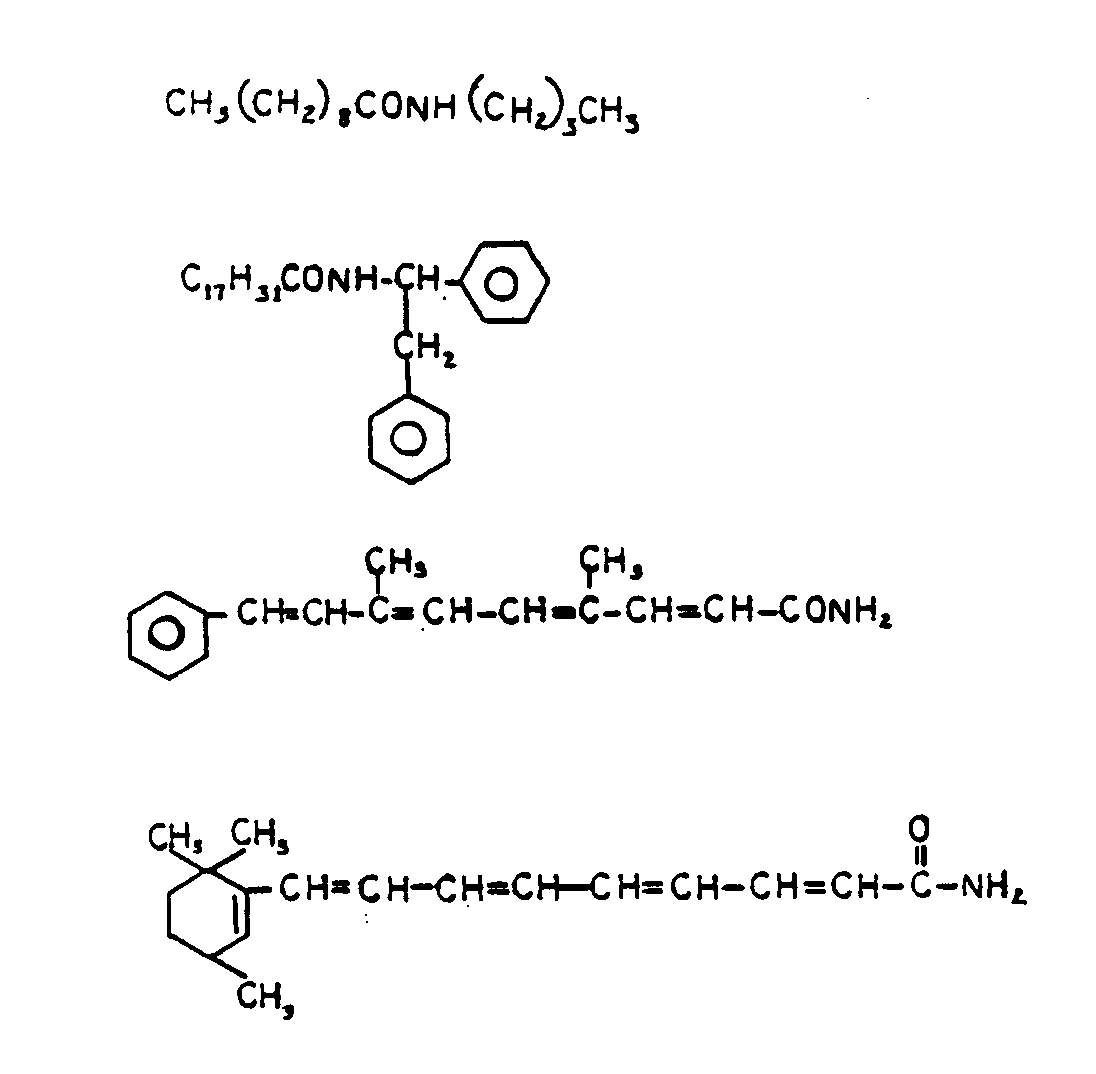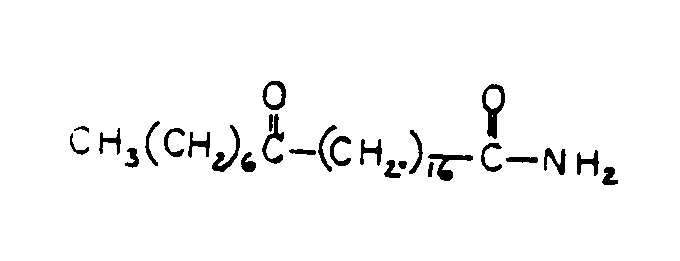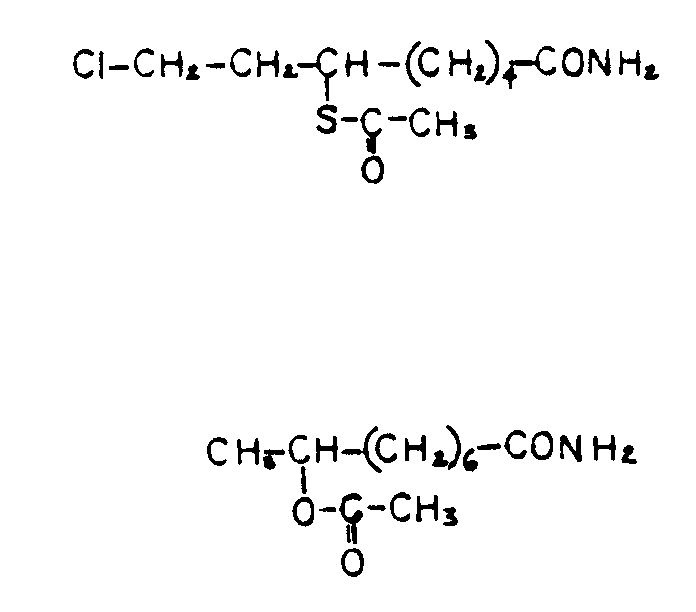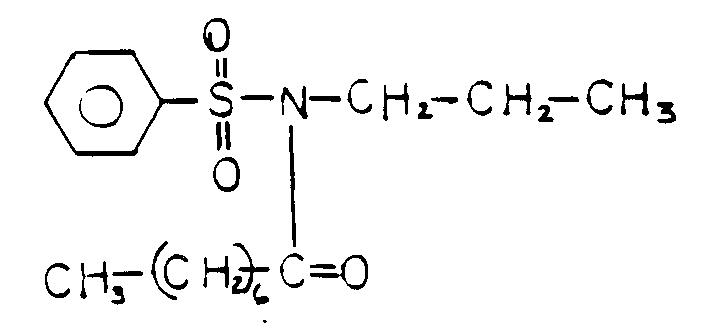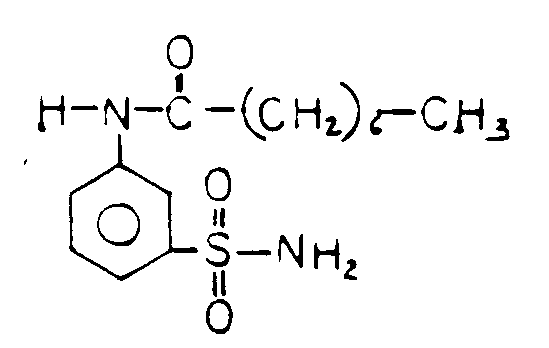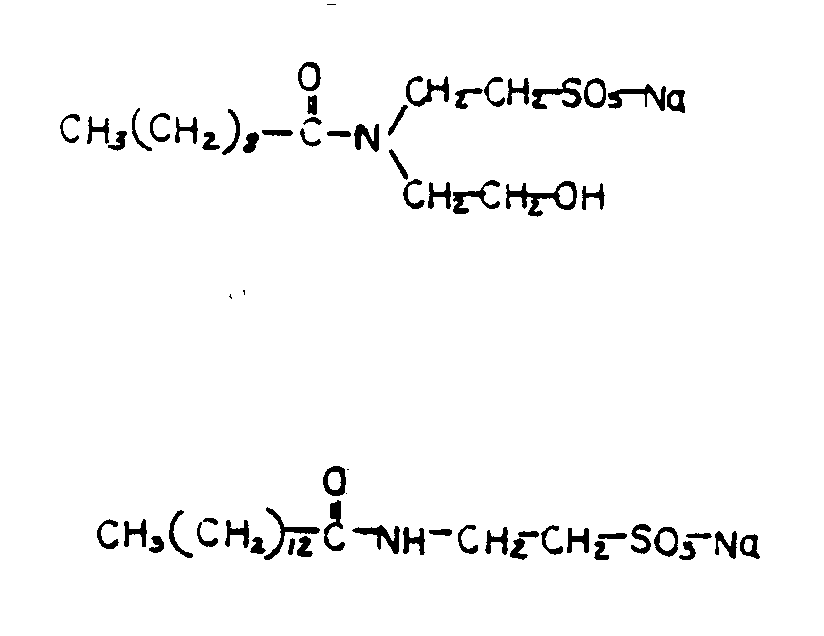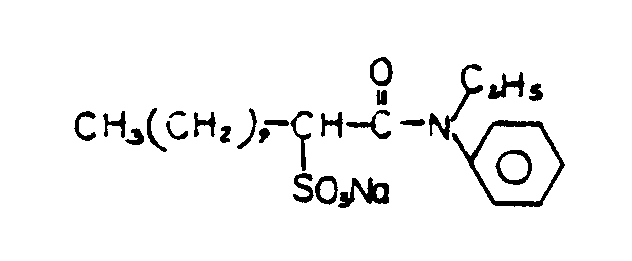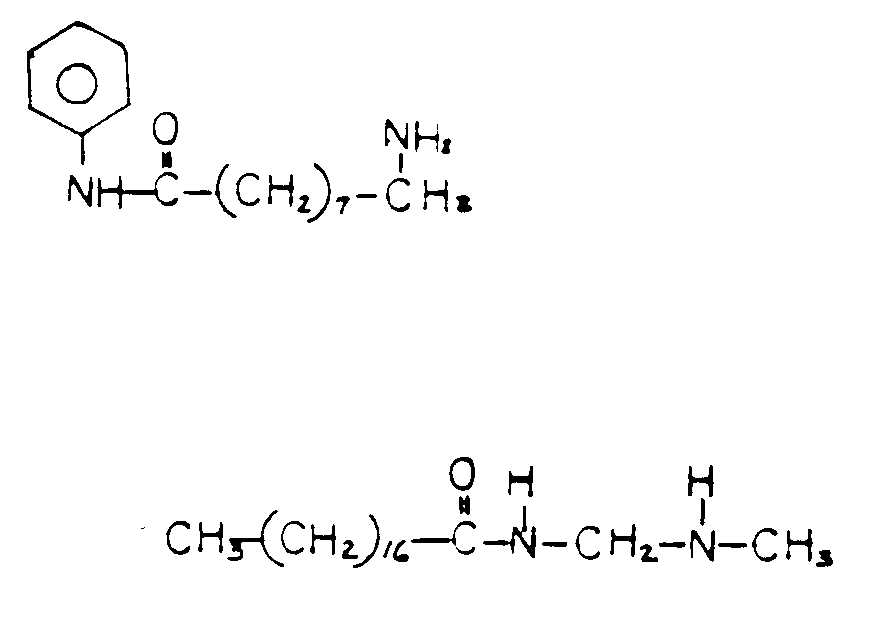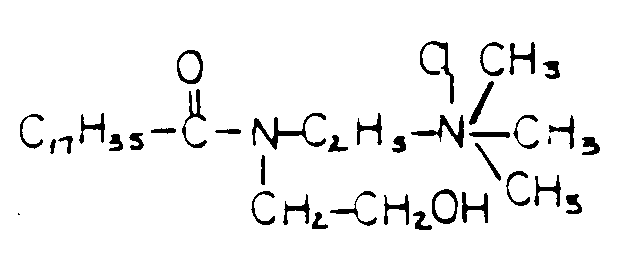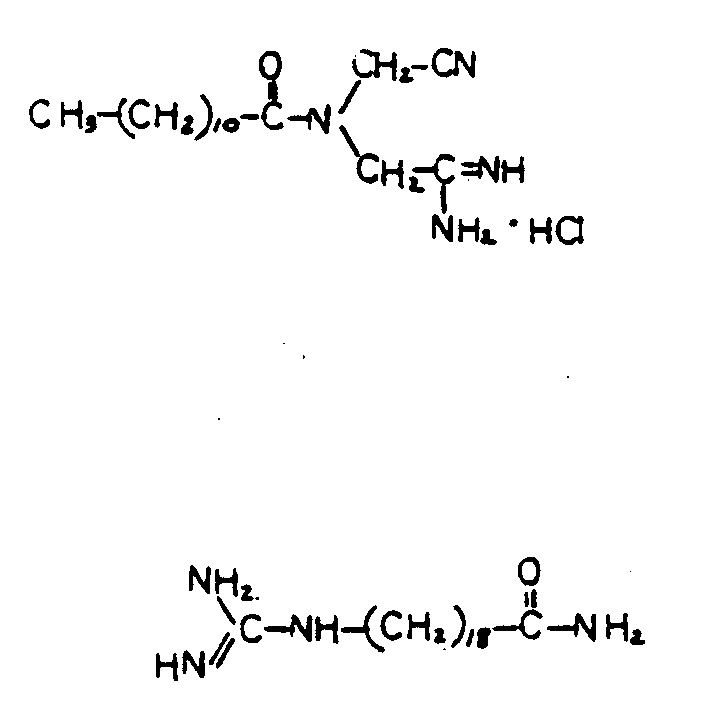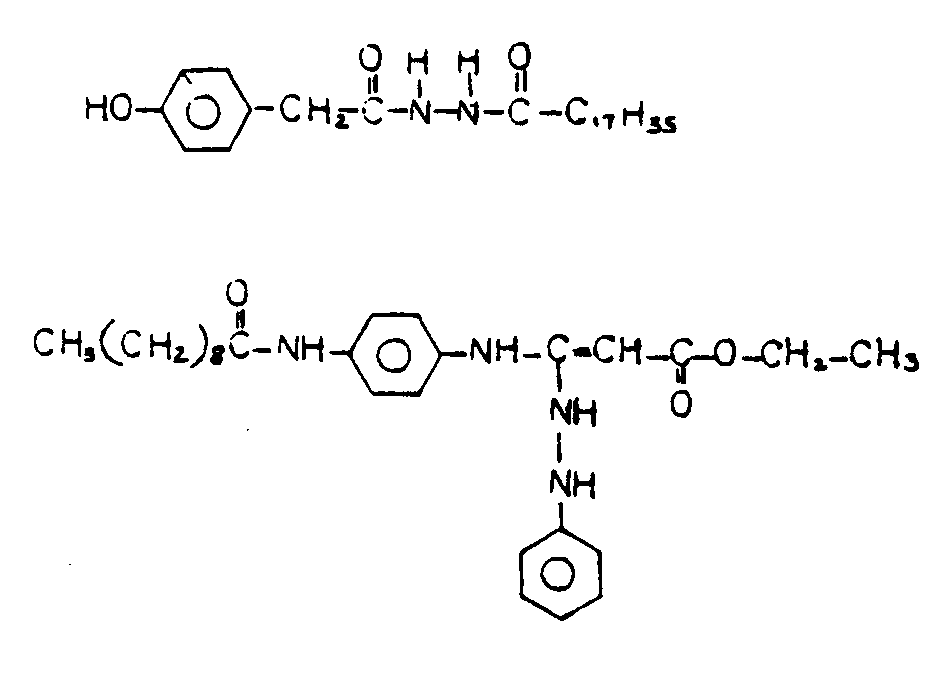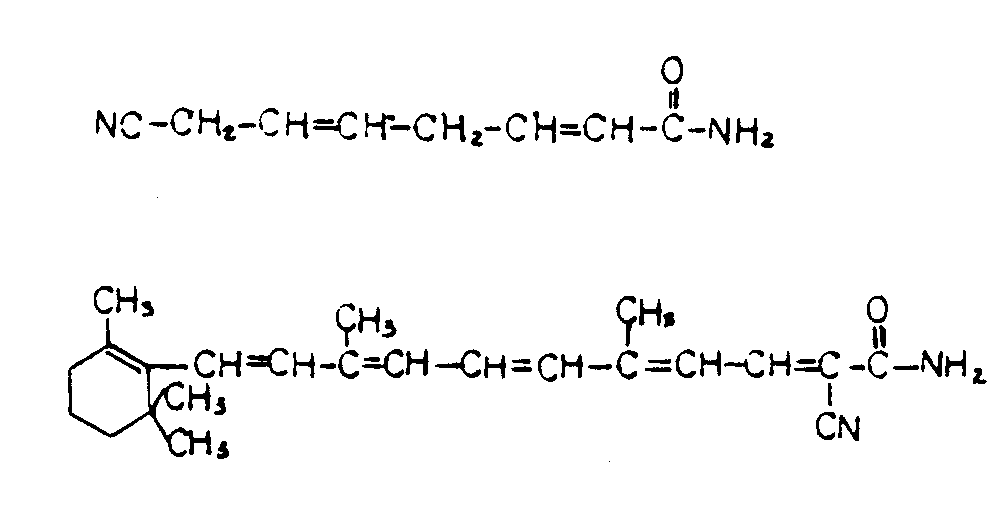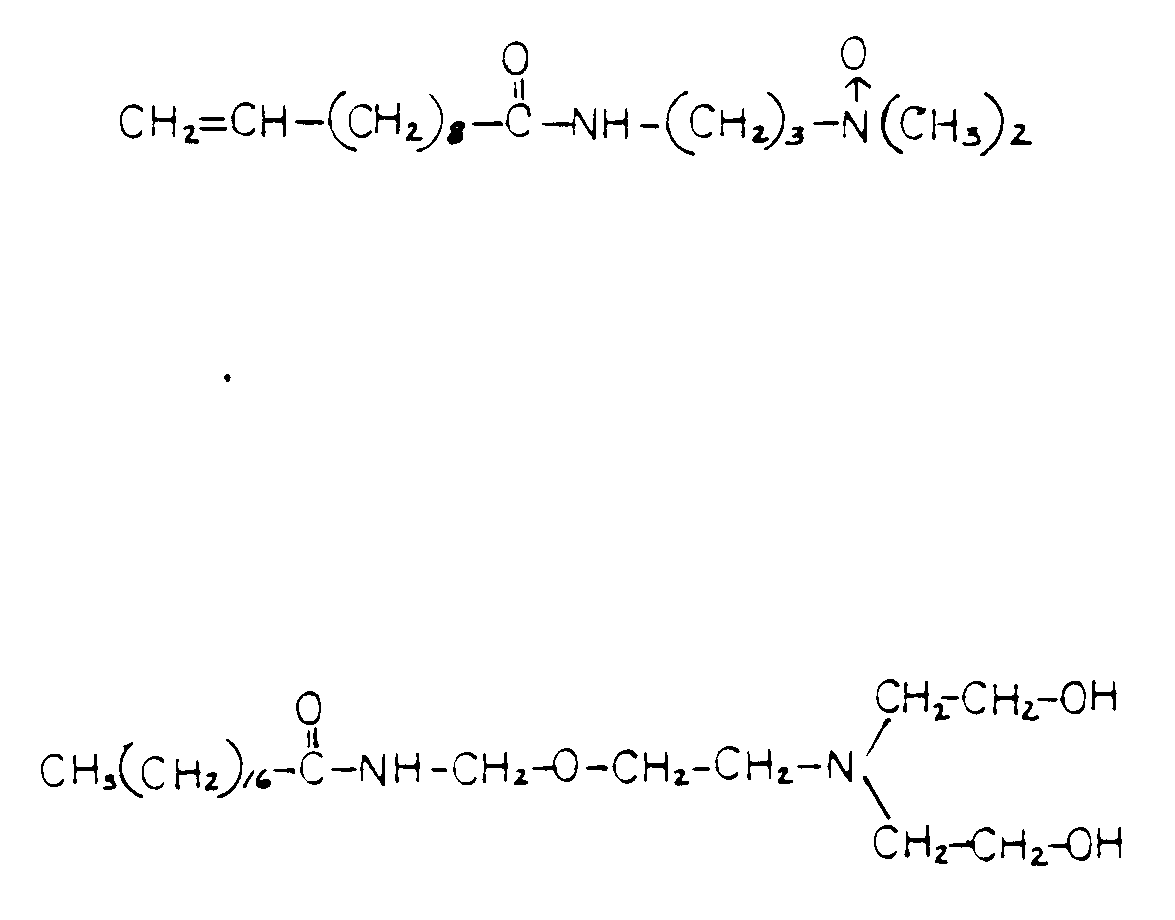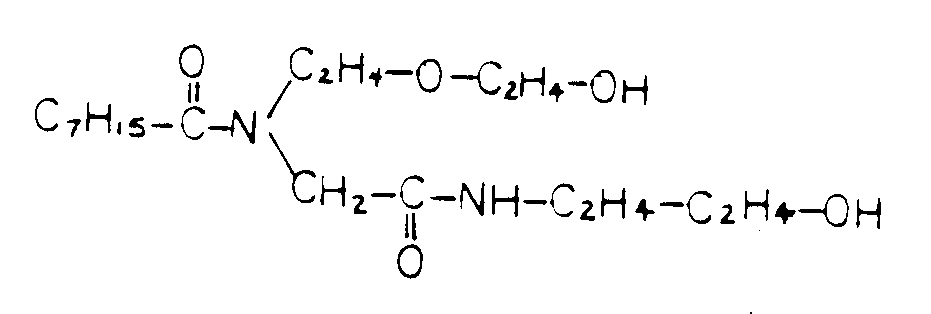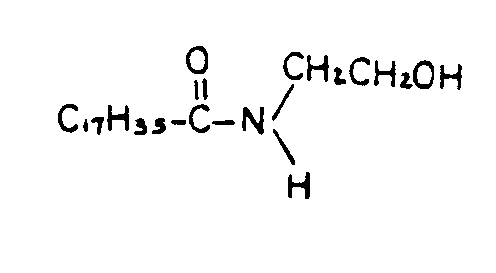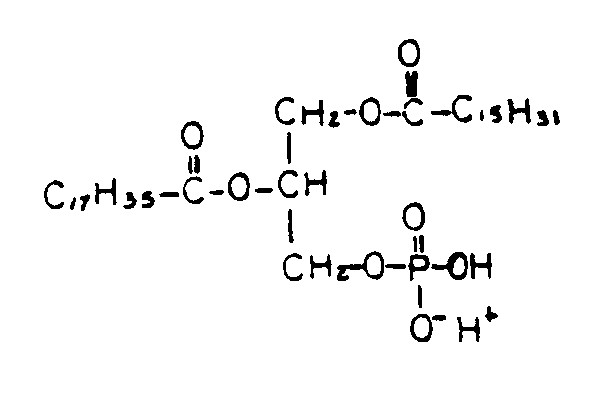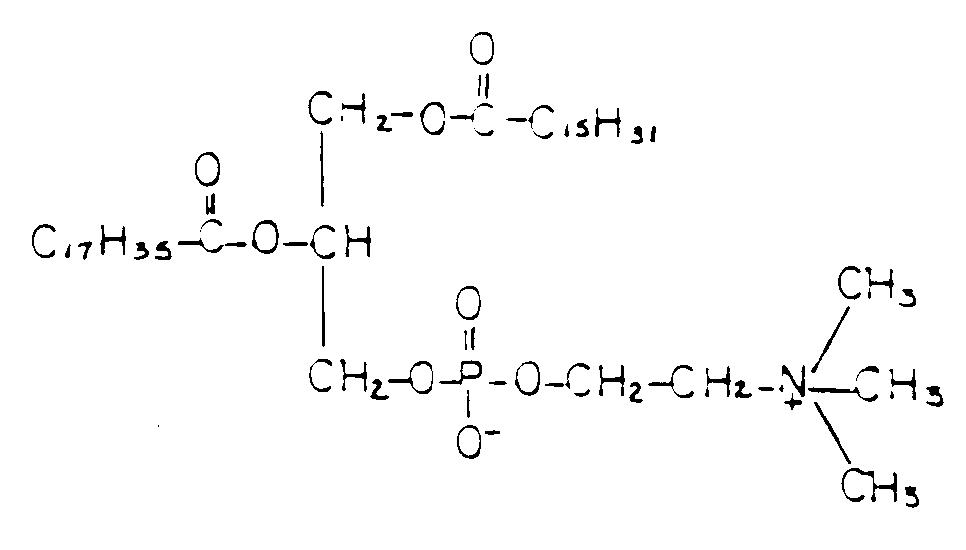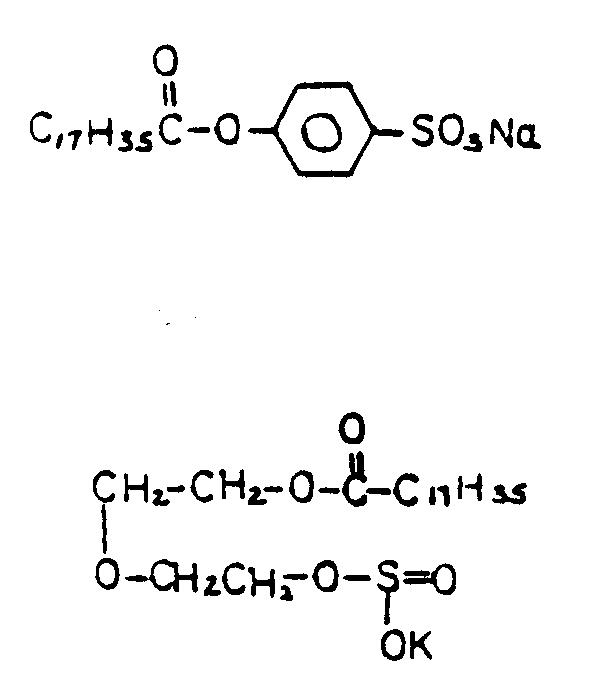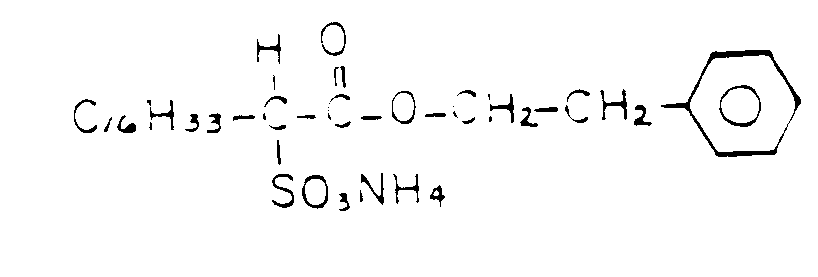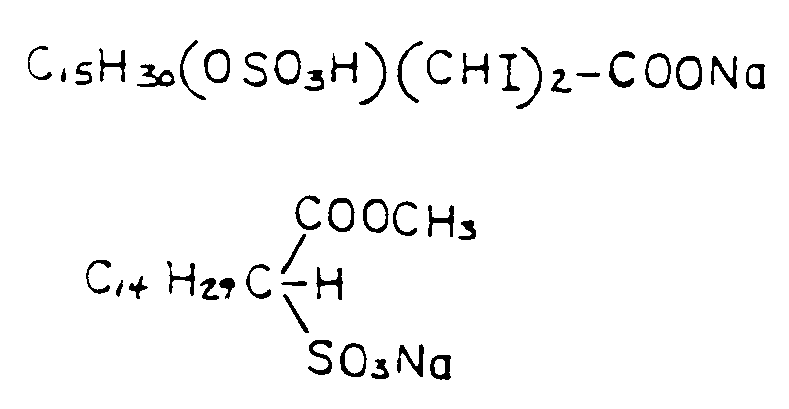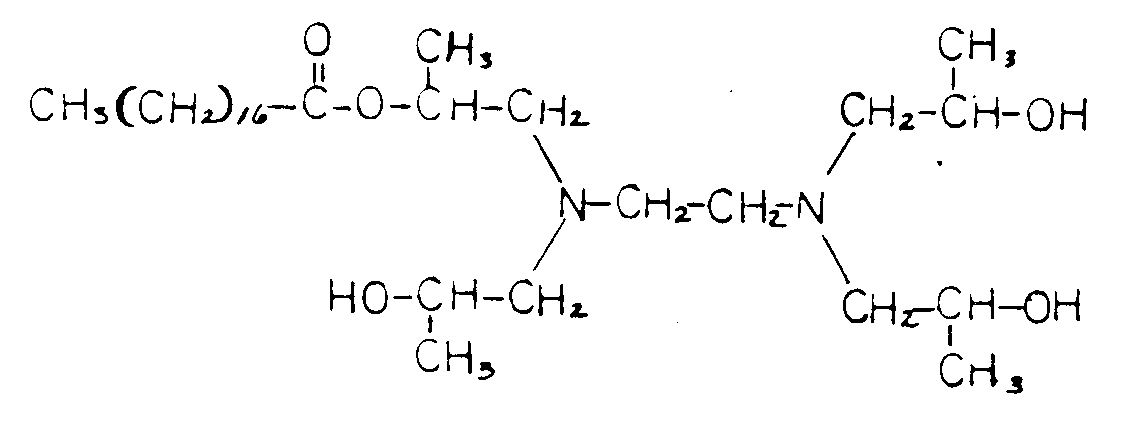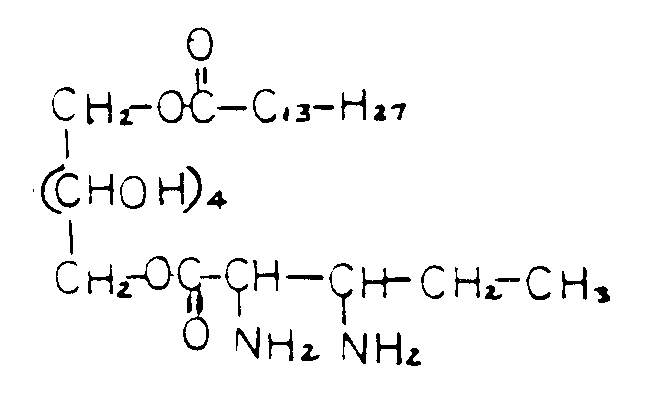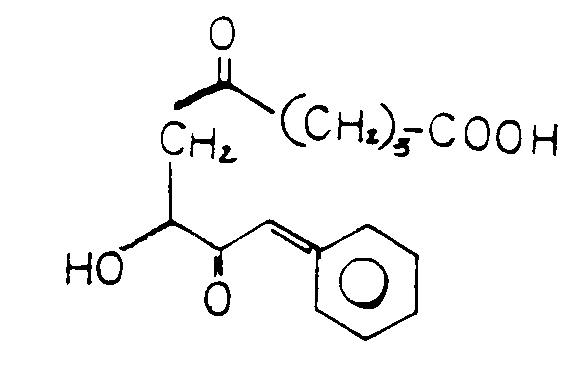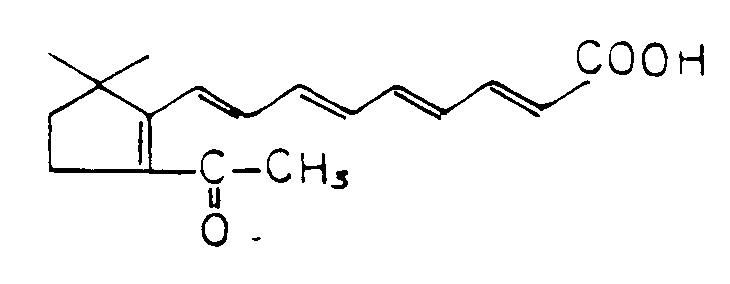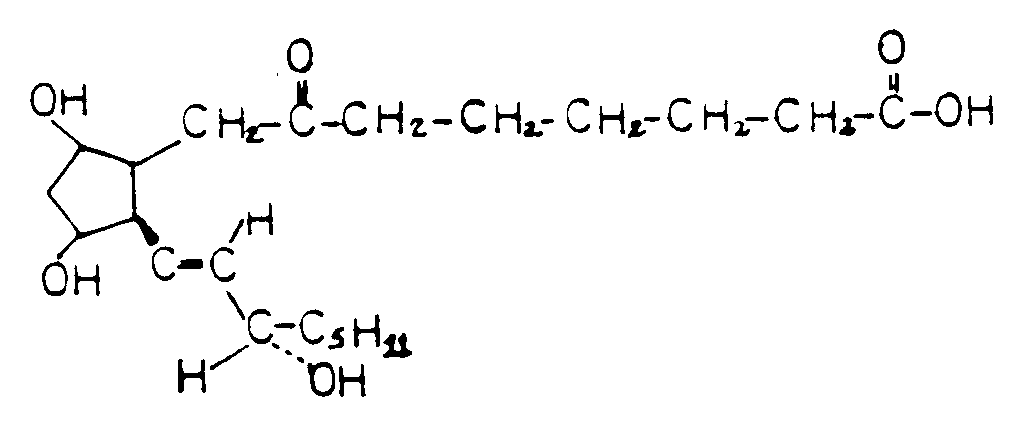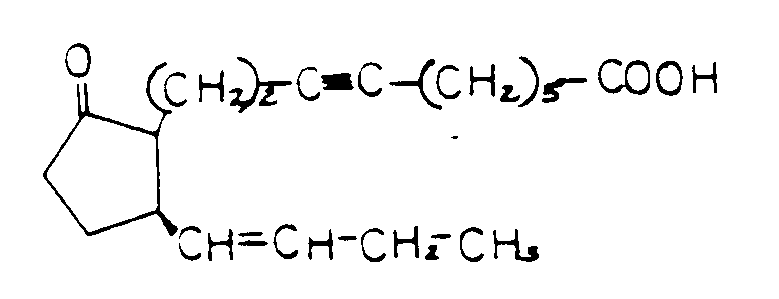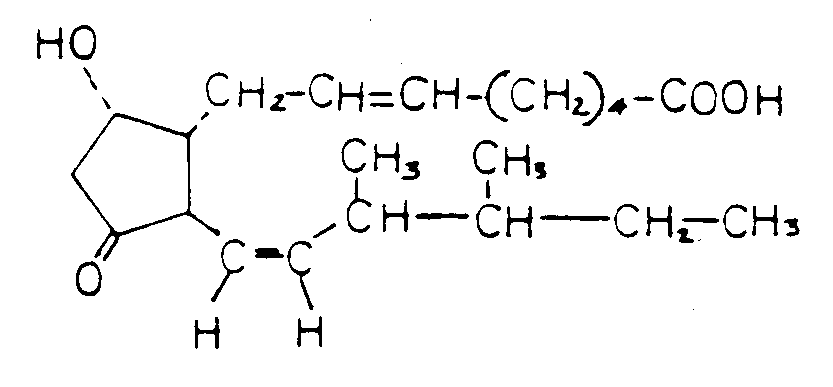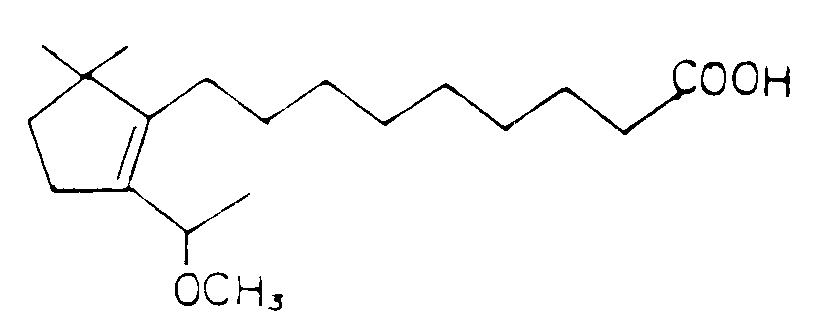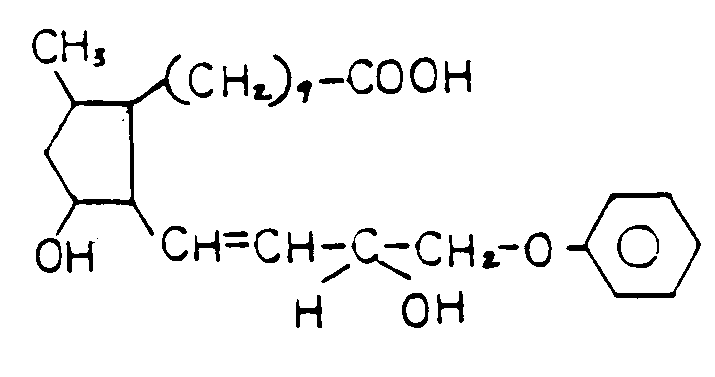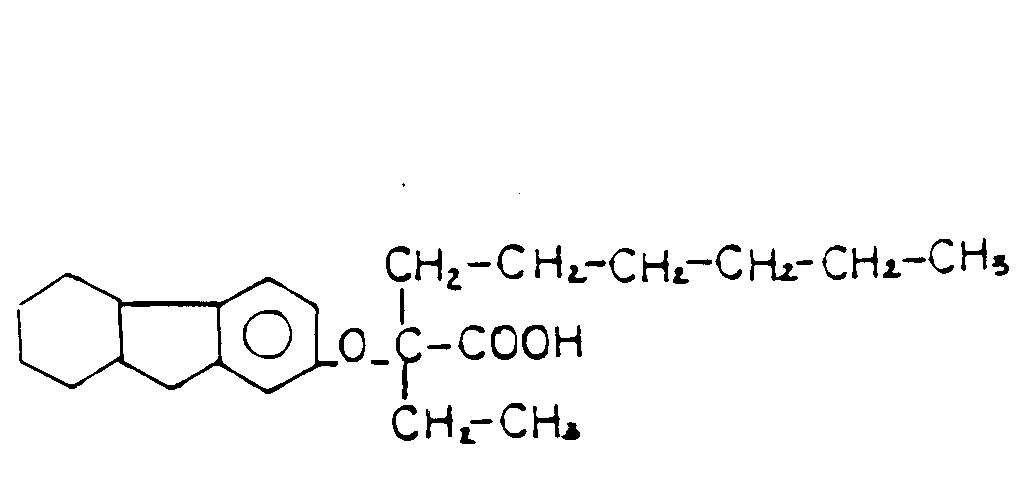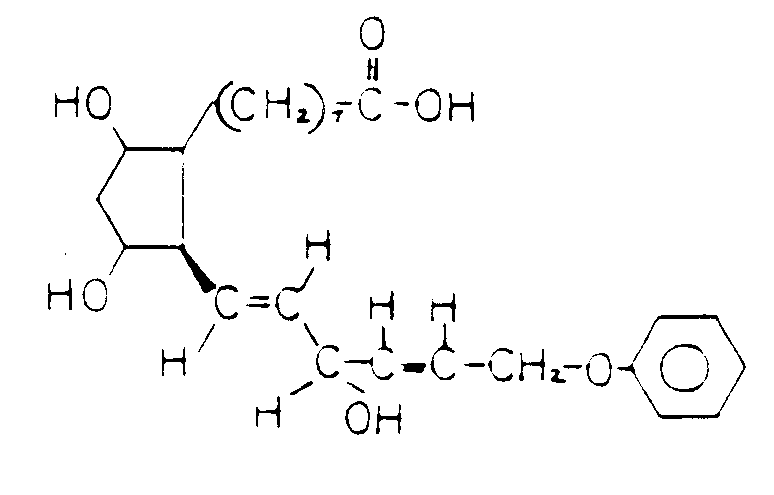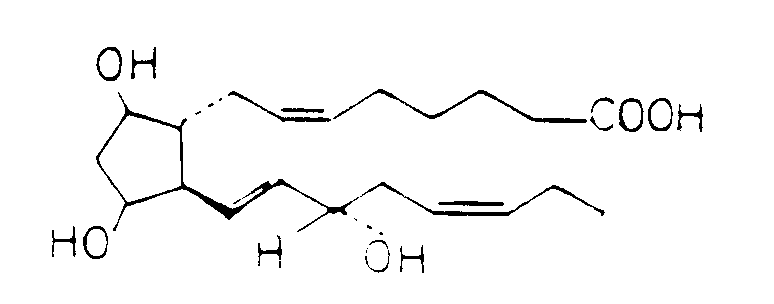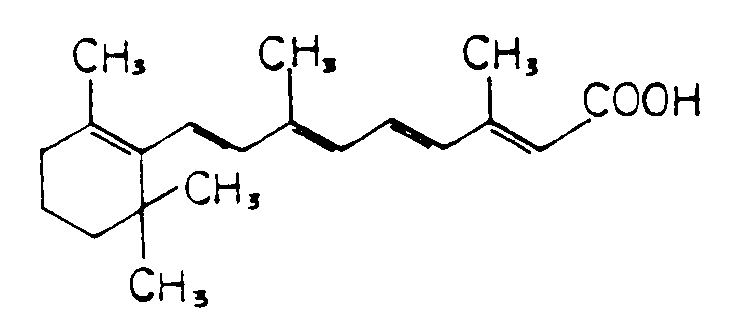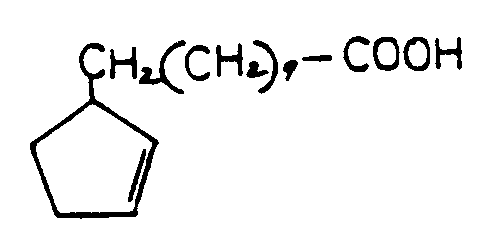![[Search a list of Patent Appplications for class 554]](../as.gif) CLASS 554, CLASS 554, | ORGANIC COMPOUNDS -- PART OF THE CLASS 532-570 SERIES |
| Click here for a printable version of this file | |
SUBCLASSES
![[List of Patents for class 554 subclass 1]](../ps.gif) 1 1 | Fatty compounds having an acid moiety which contains the carbonyl of a carboxylic acid, salt, ester, or amide group bonded directly to one end of an acyclic chain of at least seven (7) uninterrupted carbons, wherein any additional carbonyl in the acid moiety is (1) part of an aldehyde or ketone group, (2) bonded directly to a noncarbon atom which is between the additional carbonyl and the chain, or (3) attached indirectly to the chain via ionic bonding | ||||||||||||||||||||||||
This subclass is indented under subclass 1. Compounds under Class 532, ... , which are long-chain aliphatic
monocarboxylic acid derivatives, herein referred to as "fatty
compounds", characterized by having the carbonyl of (1)
a carboxylic acid, (2) a carboxylic acid salt, (3) a carboxylic
acid ester, or (4) a carboxylic acid amide bonded directly to one
end of an acyclic chain of at least seven uninterrupted carbons,
i.e., the acid moiety; wherein any additional carbonyl group in
the acid moiety is (1) part of an aldehyde or ketone group, (2) bonded
directly to a noncarbon atom which is between the additional carbonyl
and the chain, or (3) attached indirectly to the chain by ionic bonding.
SEE OR SEARCH CLASS:
| |||||||||||||||||||||||||
![[List of Patents for class 554 subclass 2]](../ps.gif) 2 2 | With preservative or stabilizer | ||||
| This subclass is indented under subclass 1. Products wherein the compound is mixed with a preserving
or stabilizing agent which functions to prevent physical or chemical
change.
SEE OR SEARCH CLASS:
| |||||
![[List of Patents for class 554 subclass 3]](../ps.gif) 3 3 | Oxygen containing hetero ring in preservative or stabilizer |
| This subclass is indented under subclass 2. Products wherein the preservative or stabilizer contains an oxygen containing hetero ring. | |
![[List of Patents for class 554 subclass 4]](../ps.gif) 4 4 | Phosphorus containing preservative or stabilizer |
| This subclass is indented under subclass 2. Products wherein the preservative or stabilizer contains phosphorus. | |
![[List of Patents for class 554 subclass 5]](../ps.gif) 5 5 | Nitrogen containing preservative or stabilizer |
| This subclass is indented under subclass 2. Products wherein the preservative or stabilizer contains nitrogen. | |
![[List of Patents for class 554 subclass 6]](../ps.gif) 6 6 | Sulfur containing preservative or stabilizer |
| This subclass is indented under subclass 2. Products wherein the preservative or stabilizer contains sulfur. | |
![[List of Patents for class 554 subclass 7]](../ps.gif) 7 7 | Phenolic preservative or stabilizer |
| This subclass is indented under subclass 2. Products wherein the preservative or stabilizer contains at least one benzene ring having at least one -OH group bonded directly thereto, wherein H of the -OH may be replaced by metal or substituted or unsubstituted ammonium. | |
![[List of Patents for class 554 subclass 8]](../ps.gif) 8 8 | Extraction directly from animal or plant source material (e.g., recovery from garbage, fish offal, slaughter house waste, whole fish, olive fruit, etc.) | ||||||||
This subclass is indented under subclass 1. Processes which include the extraction of the fatty compound(s)
directly from animal or plant source material.
SEE OR SEARCH THIS CLASS, SUBCLASS:
SEE OR SEARCH CLASS:
| |||||||||
![[List of Patents for class 554 subclass 9]](../ps.gif) 9 9 | Legume, nut, or seed source material (e.g., peanut, soya bean, rice bran, etc.) |
| This subclass is indented under subclass 8. Processes wherein the fatty compound is extracted from legumes, nuts, or seeds, such as soya beans, peanuts, flax seed, cotton seed, or portions thereof, e.g., shells, kernels, germs, oil cake, etc. | |
![[List of Patents for class 554 subclass 10]](../ps.gif) 10 10 | Fatty or sugar containing treating agent utilized (e.g., miscella, molasses, lecithin, cocoa butter used; heated cashew oil used to extract more oil from cashew nuts; using soap as emulsifier, etc.) | ||
This subclass is indented under subclass 9. Processes wherein sugar or fatty material is utilized to
facilitate extraction.
| |||
![[List of Patents for class 554 subclass 11]](../ps.gif) 11 11 | Carbon dioxide, peroxy, sulfur, nitrogen, or metal containing treating agent utilized |
| This subclass is indented under subclass 9. Processes wherein carbon dioxide or a peroxy-, sulfur-, nitrogen-, or metal-containing material is utilized facilitate extraction. | |
![[List of Patents for class 554 subclass 12]](../ps.gif) 12 12 | Organic solvent extraction | ||||
| This subclass is indented under subclass 9. Processes wherein the legume, nut, or seed source material
is subjected to the action of an organic solvent to dissolve out
the fatty compound(s).
SEE OR SEARCH THIS CLASS, SUBCLASS:
| |||||
![[List of Patents for class 554 subclass 13]](../ps.gif) 13 13 | Halogen or oxygen in the solvent (e.g., carbon tetrachloride, ethanol, etc.) |
| This subclass is indented under subclass 12. Processes wherein the solvent contains halogen or oxygen. | |
![[List of Patents for class 554 subclass 14]](../ps.gif) 14 14 | Plural diverse solvents utilized together or sequentially (e.g., solvent is mixture of acetone and hexane, ethyl and isopropyl alcohols, etc.) |
| This subclass is indented under subclass 13. Processes wherein two or more different solvents are utilized simultaneously or in succession. | |
![[List of Patents for class 554 subclass 15]](../ps.gif) 15 15 | Steam or water added |
| This subclass is indented under subclass 12. Processes wherein water or water vapor is utilized to facilitate extraction. | |
![[List of Patents for class 554 subclass 16]](../ps.gif) 16 16 | Vacuum or pressure utilized (e.g., normally gaseous hydrocarbon solvent kept liquid under pressure, etc.) | ||
This subclass is indented under subclass 12. Processes wherein the extraction is carried out under a
pressure greater or less than atmospheric.
| |||
![[List of Patents for class 554 subclass 17]](../ps.gif) 17 17 | Steam or water added or vacuum utilized |
| This subclass is indented under subclass 9. Processes wherein water vapor, water, or a pressure less than atmospheric is utilized. | |
![[List of Patents for class 554 subclass 18]](../ps.gif) 18 18 | Fish liver source material |
| This subclass is indented under subclass 8. Processes wherein fish liver is employed as the source material. | |
![[List of Patents for class 554 subclass 19]](../ps.gif) 19 19 | Sulfur, silicon, nitrogen, or metal containing treating agent utilized (e.g., salt or brine, clay, lime, etc.) |
| This subclass is indented under subclass 8. Processes wherein a material containing sulfur, silicon, nitrogen, or a metal is utilized to facilitate extraction. | |
![[List of Patents for class 554 subclass 20]](../ps.gif) 20 20 | Organic solvent extraction |
| This subclass is indented under subclass 8. Processes wherein the source material is subjected to the action of an organic solvent to dissolve out the fatty compound. | |
![[List of Patents for class 554 subclass 21]](../ps.gif) 21 21 | Halogen or oxygen in the solvent (e.g., trichloroethylene, alcohol, etc.) |
| This subclass is indented under subclass 20. Processes wherein the solvent contains halogen or oxygen. | |
![[List of Patents for class 554 subclass 22]](../ps.gif) 22 22 | Vacuum utilized |
| This subclass is indented under subclass 8. Processes wherein a pressure less than atmospheric is utilized. | |
![[List of Patents for class 554 subclass 23]](../ps.gif) 23 23 | Steam or water added (e.g., wet rendering, etc.) | ||
This subclass is indented under subclass 8. Processes wherein water vapor or water is added to the source
material to facilitate extraction.
| |||
![[List of Patents for class 554 subclass 24]](../ps.gif) 24 24 | Chemical modification of oils to improve their drying properties and products thereof | ||||||
This subclass is indented under subclass 1. Processes which are directed to chemically treating fatty
oils to impart drying or film-forming properties thereto, and the
products produced by said treatment.
SEE OR SEARCH CLASS:
| |||||||
![[List of Patents for class 554 subclass 25]](../ps.gif) 25 25 | Polymerization process and product thereof (e.g., thermal polymerization, oxidative polymerization, etc.) | ||||
This subclass is indented under subclass 24. Processes which are directed to polymerizing an oil, such
as by heating or oxidizing, and the polymerized products resulting
therefrom.
| |||||
![[List of Patents for class 554 subclass 26]](../ps.gif) 26 26 | Additional organic compound utilized (e.g., as catalyst, promoter, etc.) |
| This subclass is indented under subclass 25. Processes which include, in addition to the oil reactant, at least one other organic compound in the polymerization reaction, such as a catalyst, promoter, or reactant. | |
![[List of Patents for class 554 subclass 27]](../ps.gif) 27 27 | The additional organic compound is an ethylenically unsaturated hydrocarbon monomer (e.g., butadiene, cyclopentadiene, styrene, etc.) |
| This subclass is indented under subclass 26. Processes wherein the additional organic compound is an ethylenically unsaturated monomer containing hydrogen and carbon only. | |
![[List of Patents for class 554 subclass 28]](../ps.gif) 28 28 | Inorganic material utilized |
| This subclass is indented under subclass 25. Processes wherein an inorganic material is utilized in the polymerization reaction. | |
![[List of Patents for class 554 subclass 29]](../ps.gif) 29 29 | Purification or recovery |
| This subclass is indented under subclass 25. Processes which include separating the polymerized product from impurities or from the reaction mixture. | |
![[List of Patents for class 554 subclass 30]](../ps.gif) 30 30 | Esterification or molecular rearrangement (e.g., intra- or inter-esterification, etc.) |
| This subclass is indented under subclass 24. Processes which include esterification or wherein a starting material is treated, such as by heat or with catalysts, to cause a rearrangement of elements. | |
![[List of Patents for class 554 subclass 31]](../ps.gif) 31 31 | Dehydration or carbon to carbon unsaturation formation (e.g., dehydrating hydroxylated fatty acids or oils, forming conjugated unsaturation by dehydrogenation, dehalogenation, dehydrohalogenation, etc.) | ||
This subclass is indented under subclass 24. Processes which are directed to dehydrating a starting material
or forming carbon to carbon unsaturation in a starting material
to impart drying properties thereto.
| |||
![[List of Patents for class 554 subclass 32]](../ps.gif) 32 32 | Heavy metal containing compound utilized (e.g., as catalyst, promoter, etc.) |
| This subclass is indented under subclass 31. Processes wherein a compound containing a metal having a specific gravity greater than four is utilized, e.g., as reactant, catalyst, promoter, etc. | |
![[List of Patents for class 554 subclass 33]](../ps.gif) 33 33 | Sulfur containing compound utilized |
| This subclass is indented under subclass 31. Processes wherein a compound containing sulfur is utilized. | |
![[List of Patents for class 554 subclass 34]](../ps.gif) 34 34 | Group IA or IIA light metal containing compound utilized | ||
This subclass is indented under subclass 31. Processes wherein a compound containing a Group IA or Group
IIA light metal is utilized.
| |||
![[List of Patents for class 554 subclass 35]](../ps.gif) 35 35 | The carbonyl is part of a carboxamide group (i.e., fatty acid amides) | ||||
This subclass is indented under subclass 1. Compounds which are fatty acid amides, i.e., compounds having
an acyclic chain of at least seven uninterrupted carbons bonded
directly to the carbonyl of a -C(=O)- NH(H) group, wherein
the hydrogens may be substituted.
SEE OR SEARCH CLASS:
| |||||
![[List of Patents for class 554 subclass 36]](../ps.gif) 36 36 | Additional carbonyl in the acid moiety | ||
This subclass is indented under subclass 35. Compounds wherein an additional carbonyl is in the acid
moiety.
| |||
![[List of Patents for class 554 subclass 37]](../ps.gif) 37 37 | Noncarbon atom bonded directly to the additional carbonyl | ||
This subclass is indented under subclass 36. Compounds wherein an atom other carbon is bonded directly
to the additional carbonyl.
| |||
![[List of Patents for class 554 subclass 38]](../ps.gif) 38 38 | Heavy metal or aluminum containing |
| This subclass is indented under subclass 35. Compounds which contain aluminum or a metal having a specific gravity greater than four. | |
![[List of Patents for class 554 subclass 39]](../ps.gif) 39 39 | Boron, silicon, selenium, or tellurium containing |
| This subclass is indented under subclass 35. Compounds which contain boron, silicon, selenium, or tellurium. | |
![[List of Patents for class 554 subclass 40]](../ps.gif) 40 40 | Phosphorus containing |
| This subclass is indented under subclass 35. Compounds which contain phosphorus. | |
![[List of Patents for class 554 subclass 41]](../ps.gif) 41 41 | Additional nitrogen containing |
| This subclass is indented under subclass 40. Compounds which contain nitrogen in addition to the carboxamide nitrogen. | |
![[List of Patents for class 554 subclass 42]](../ps.gif) 42 42 | Sulfur containing |
| This subclass is indented under subclass 35. Compounds which contain sulfur. | |
![[List of Patents for class 554 subclass 43]](../ps.gif) 43 43 | The sulfur is bonded directly to the carboxamide nitrogen or to an additional nitrogen (e.g., sulfonamide, sulfamic acid, etc.) | ||
This subclass is indented under subclass 42. Compounds wherein sulfur is bonded directly to the carboxamide
nitrogen or to an additional nitrogen.
| |||
![[List of Patents for class 554 subclass 44]](../ps.gif) 44 44 | Sulfoxy containing |
| This subclass is indented under subclass 42. Compounds which contain oxygen bonded directly to sulfur. | |
![[List of Patents for class 554 subclass 45]](../ps.gif) 45 45 | Ring bonded directly to the sulfoxy |
| This subclass is indented under subclass 44. Compounds wherein the sulfoxy group is bonded directly to a ring. | |
![[List of Patents for class 554 subclass 46]](../ps.gif) 46 46 | Additional nitrogen containing |
| This subclass is indented under subclass 44. Compounds which contain nitrogen in addition to the carboxamide nitrogen. | |
![[List of Patents for class 554 subclass 47]](../ps.gif) 47 47 | Containing -C(=O)O- group (e.g., carboxylic acid, ester, salt, etc.) | ||
This subclass is indented under subclass 46. Compounds which contain a -O- group.
| |||
![[List of Patents for class 554 subclass 48]](../ps.gif) 48 48 | Additional carboxamide containing |
| This subclass is indented under subclass 46. Compounds which contain two or more carboxamide groups. | |
![[List of Patents for class 554 subclass 49]](../ps.gif) 49 49 | The carboxamide nitrogen and a -S(=O)(=O)-O-X group attached to each other by an acyclic chain which consists of carbons, wherein X is hydrogen or a metal (e.g., taurides, etc.) | ||
This subclass is indented under subclass 44. Compounds wherein the carboxamide nitrogen and a -S(=O)(=O)-O-X
group are attached to each other through an acyclic carbon chain, where
X is hydrogen or a metal.
| |||
![[List of Patents for class 554 subclass 50]](../ps.gif) 50 50 | Sulfoxy in acid moiety | ||
This subclass is indented under subclass 44. Compounds which contain sulfur bonded directly to oxygen
in the acid moiety of the carboxamide.
| |||
![[List of Patents for class 554 subclass 51]](../ps.gif) 51 51 | Additional nitrogen containing | ||
This subclass is indented under subclass 35. Compounds which contain plural nitrogens, i.e., nitrogen
in addition to the carboxamide nitrogen.
| |||
![[List of Patents for class 554 subclass 52]](../ps.gif) 52 52 | Quaternary ammonium containing | ||
This subclass is indented under subclass 51. Compounds wherein the additional nitrogen is in a quaternary
ammonium group; i.e., a pentavalent nitrogen is bonded by four valences
to carbon.
| |||
![[List of Patents for class 554 subclass 53]](../ps.gif) 53 53 | Amidino or guanidino containing | ||
This subclass is indented under subclass 51. Compounds which contain the -NH2 or
-NH-NH2 group, wherein substitution may be
made for hydrogen only.
| |||
![[List of Patents for class 554 subclass 54]](../ps.gif) 54 54 | Cyano or hydrazino containing | ||
This subclass is indented under subclass 51. Compounds which contain a -CN group or a -NH-NH2 group,
wherein substitution may be made for hydrogen only.
| |||
![[List of Patents for class 554 subclass 55]](../ps.gif) 55 55 | Halogen or additional oxygen containing (e.g., isocyanate containing, etc.) | ||
This subclass is indented under subclass 51. Compounds which contain halogen or plural oxygens, i.e.,
oxygen in addition to the carboxamide oxygen.
| |||
![[List of Patents for class 554 subclass 56]](../ps.gif) 56 56 | Additional carboxamide group containing (e.g., carbamates, ureas, etc.) | ||
This subclass is indented under subclass 55. Compounds which contain at least two carboxamide groups.
| |||
![[List of Patents for class 554 subclass 57]](../ps.gif) 57 57 | Plural additional carboxamide groups containing | ||
This subclass is indented under subclass 56. Compounds which contain three or more carboxamide group.
| |||
![[List of Patents for class 554 subclass 58]](../ps.gif) 58 58 | Additional nitrogen or -C(=O)O- group containing |
| This subclass is indented under subclass 56. Compounds which contain a -O- group or nitrogen in addition to those in the two carboxamide groups. | |
![[List of Patents for class 554 subclass 59]](../ps.gif) 59 59 | Containing -C(=O)O- group |
| This subclass is indented under subclass 55. Compounds wherein the additional oxygen is in a O- group. | |
![[List of Patents for class 554 subclass 60]](../ps.gif) 60 60 | Nitro containing or plural oxyalkylene groups bonded directly to each other |
| This subclass is indented under subclass 55. Compounds wherein the additional oxygen is in a nitro group or in a group composed of two or more oxyalkylene groups bonded directly to each other. | |
![[List of Patents for class 554 subclass 61]](../ps.gif) 61 61 | Additional oxygen containing (e.g., amides of ricinoleic acid, etc.) |
| This subclass is indented under subclass 35. Compounds which contain plural oxygens, i.e., oxygen in addition to the carboxamide oxygen. | |
![[List of Patents for class 554 subclass 62]](../ps.gif) 62 62 | Halogen containing |
| This subclass is indented under subclass 61. Compounds which contain halogen. | |
![[List of Patents for class 554 subclass 63]](../ps.gif) 63 63 | Containing -C(=O)O- group |
| This subclass is indented under subclass 61. Compounds which contain a -O- group. | |
![[List of Patents for class 554 subclass 64]](../ps.gif) 64 64 | Plural oxyalkylene groups bonded directly to each other |
| This subclass is indented under subclass 61. Compounds which contain two or more oxyalkylene groups; i.e., -O-Alkyl-, bonded directly to each other. | |
![[List of Patents for class 554 subclass 65]](../ps.gif) 65 65 | Oxygen bonded directly to a ring |
| This subclass is indented under subclass 61. Compounds wherein the oxygen is bonded directly to a ring. | |
![[List of Patents for class 554 subclass 66]](../ps.gif) 66 66 | Hydroxyalkyl substituent on the amido nitrogen | ||
This subclass is indented under subclass 61. Compounds which contain an hydroxyalkyl group bonded directly
to the carboxamide nitrogen through a carbon of the group.
| |||
![[List of Patents for class 554 subclass 67]](../ps.gif) 67 67 | Halogen containing |
| This subclass is indented under subclass 35. Compounds which contain halogen. | |
![[List of Patents for class 554 subclass 68]](../ps.gif) 68 68 | Processes |
| This subclass is indented under subclass 35. Processes which are directed to the preparation, recovery, or treatment of a fatty acid amide. | |
![[List of Patents for class 554 subclass 69]](../ps.gif) 69 69 | Amidation |
| This subclass is indented under subclass 68. Processes which are directed to the formation of the carboxamide group; e.g., by reacting a fatty acid, salt, ester, acid halide, or anhydride with ammonia or an amino nitrogen containing compound. | |
![[List of Patents for class 554 subclass 70]](../ps.gif) 70 70 | Purification or recovery |
| This subclass is indented under subclass 68. Processes which are directed to separating the fatty acid amide from impurities or from the reaction mixture. | |
![[List of Patents for class 554 subclass 71]](../ps.gif) 71 71 | Heavy metal containing (e.g., As, Cr, Mn, Sb, V, etc.) |
| This subclass is indented under subclass 1. Compounds which contain a metal having a specific gravity greater than four. | |
![[List of Patents for class 554 subclass 72]](../ps.gif) 72 72 | Titanium, zirconium, or cerium containing (Ti, Zr, or Ce) |
| This subclass is indented under subclass 71. Compound wherein the heavy metal is titanium, zirconium, or cerium. | |
![[List of Patents for class 554 subclass 73]](../ps.gif) 73 73 | Lead or tin containing (Pb or Sn) |
| This subclass is indented under subclass 71. Compounds wherein the heavy metal is lead or tin. | |
![[List of Patents for class 554 subclass 74]](../ps.gif) 74 74 | Iron, cobalt, nickel, copper, silver, or gold containing (Fe, Co, Ni, Cu, Ag, or Au) |
| This subclass is indented under subclass 71. Compounds wherein the heavy metal is iron, cobalt, nickel, copper, silver, or gold. | |
![[List of Patents for class 554 subclass 75]](../ps.gif) 75 75 | Zinc, cadmium, or mercury containing (Zn, Cd, or Hg) |
| This subclass is indented under subclass 71. Compounds wherein the heavy metal is zinc, cadmium, or mercury. | |
![[List of Patents for class 554 subclass 76]](../ps.gif) 76 76 | Aluminum containing |
| This subclass is indented under subclass 1. Compounds which contain aluminum. | |
![[List of Patents for class 554 subclass 77]](../ps.gif) 77 77 | Boron, selenium, or silicon containing |
| This subclass is indented under subclass 1. Compounds which contain boron, selenium, or silicon. | |
![[List of Patents for class 554 subclass 78]](../ps.gif) 78 78 | Phosphorus containing |
| This subclass is indented under subclass 1. Compounds which contain phosphorus. | |
![[List of Patents for class 554 subclass 79]](../ps.gif) 79 79 | Glycerophosphates (e.g., phosphatidic acids, phosphatidyl inositol, etc.) | ||||
This subclass is indented under subclass 78. Compounds which are phosphoric acid glycerol esters containing
a fatty acid moiety.
| |||||
![[List of Patents for class 554 subclass 80]](../ps.gif) 80 80 | Nitrogen containing (e.g., cephalins, lecithins, etc.) | ||
This subclass is indented under subclass 79. Compounds which contain nitrogen.
| |||
![[List of Patents for class 554 subclass 81]](../ps.gif) 81 81 | Halogen or sulfur containing |
| This subclass is indented under subclass 80. Compounds which contain halogen or sulfur. | |
![[List of Patents for class 554 subclass 82]](../ps.gif) 82 82 | Processes of forming the compound |
| This subclass is indented under subclass 80. Processes which are directed to the preparation of nitrogen containing glycerophosphates. | |
![[List of Patents for class 554 subclass 83]](../ps.gif) 83 83 | Purification on recovery |
| This subclass is indented under subclass 80. Processes which include separating the compound from impurities or the reaction mixture. | |
![[List of Patents for class 554 subclass 84]](../ps.gif) 84 84 | Nitrogen containing |
| This subclass is indented under subclass 78. Compounds which contain nitrogen. | |
![[List of Patents for class 554 subclass 85]](../ps.gif) 85 85 | Sulfur containing |
| This subclass is indented under subclass 1. Compounds which contain sulfur. | |
![[List of Patents for class 554 subclass 86]](../ps.gif) 86 86 | Processes utilizing sulfur chloride |
| This subclass is indented under subclass 85. Processes wherein the sulfur containing compound is treated with or prepared in a reaction utilizing sulfur chloride. | |
![[List of Patents for class 554 subclass 87]](../ps.gif) 87 87 | Processes utilizing elemental sulfur |
| This subclass is indented under subclass 85. Processes wherein the sulfur containing compound is treated with or prepared in a reaction utilizing elemental sulfur. | |
![[List of Patents for class 554 subclass 88]](../ps.gif) 88 88 | Sulfoxy containing (e.g., sulfones, etc.) | ||
This subclass is indented under subclass 85. Compounds which contain oxygen bonded directly to sulfur.
| |||
![[List of Patents for class 554 subclass 89]](../ps.gif) 89 89 | Twitchell or Pfeilring reagent (i.e., product of sulfonation of fatty material in the presence of an aromatic hydrocarbon or phenol) | ||
This subclass is indented under subclass 88. Compounds which are sulfo-aromatic fatty acids prepared
by the action of sulfuric acid on an aromatic hydrocarbon such as
naphthalene, and a fatty compound, such as castor oil or oleic acid.
| |||
![[List of Patents for class 554 subclass 90]](../ps.gif) 90 90 | The sulfoxy is in the alcohol moiety (e.g., sulfate esters of fatty acid monoglycerides, etc.) | ||
This subclass is indented under subclass 88. Compounds wherein the sulfoxy is in the alcohol moiety.
| |||
![[List of Patents for class 554 subclass 91]](../ps.gif) 91 91 | Nitrogen bonded directly to carbon in the alcohol moiety |
| This subclass is indented under subclass 90. Compounds which contain nitrogen bonded directly to carbon in the alcohol moiety. | |
![[List of Patents for class 554 subclass 92]](../ps.gif) 92 92 | Having -S(=O)(=O)-O-X attached indirectly to the single bonded oxygen of the carboxyl group by a single carbon or a chain consisting of carbons, which chain or carbon may include a ring, wherein X is hydrogen or a cation (e.g., isethionates, etc.) | ||
This subclass is indented under subclass 90. Compounds wherein-S(=O)(=O)-O-X is attached
indirectly through a single carbon or carbon chain to the single
bonded oxygen of the -O- group, wherein X is hydrogen or a cation.
| |||
![[List of Patents for class 554 subclass 93]](../ps.gif) 93 93 | Purification or recovery |
| This subclass is indented under subclass 90. Processes which include separating the compound from impurities or from the reaction mixture. | |
![[List of Patents for class 554 subclass 94]](../ps.gif) 94 94 | Nitrogen containing (e.g., sulfonamide containing, etc.) | ||
This subclass is indented under subclass 88. Compounds which contain nitrogen.
| |||
![[List of Patents for class 554 subclass 95]](../ps.gif) 95 95 | Carbocyclic ring in the acid moiety | ||
This subclass is indented under subclass 88. Compounds which contain a carbocyclic ring in the acid moiety.
| |||
![[List of Patents for class 554 subclass 96]](../ps.gif) 96 96 | Carbon bonded directly to -S(=O)(=O)OH or to -O-S(=O)(=O)OH, wherein H may be replaced by a cation or by an ester forming group (e.g., sulfonic acid sulfate monoester, etc.) |
| This subclass is indented under subclass 88. Compounds which contain a sulfonic acid or a sulfate monoester substituent, or a salt or ester of the substituent. | |
![[List of Patents for class 554 subclass 97]](../ps.gif) 97 97 | Metal salt | ||
This subclass is indented under subclass 96. Compounds which are metal salts.
| |||
![[List of Patents for class 554 subclass 98]](../ps.gif) 98 98 | Processes utilizing anhydrous sulfur trioxide (e.g., in gaseous form, in sulfur dioxide solution, etc.) |
| This subclass is indented under subclass 96. Processes which are directed to preparing the compound by reacting anhydrous sulfur trioxide. | |
![[List of Patents for class 554 subclass 99]](../ps.gif) 99 99 | Processes of sulfonating in the presence of lower carboxylic acid, anhydride, acid halide, or phosphorus containing material |
| This subclass is indented under subclass 96. Processes wherein the compound is prepared by a sulfonation reaction which is carried out in the presence of (1) a lower carboxylic acid (i.e., the uninterrupted carbon chain in the acid moiety contains fewer than seven carbons), (2) an anhydride thereof, (3) an acid halide thereof, or (4) a phosphorus containing material. | |
![[List of Patents for class 554 subclass 100]](../ps.gif) 100 100 | Purification or recovery |
| This subclass is indented under subclass 96. Processes which are directed to separating the compound from impurities or from the reaction mixture. | |
![[List of Patents for class 554 subclass 101]](../ps.gif) 101 101 | Thioether, thiol, or mercaptide containing |
| This subclass is indented under subclass 85. Compounds which contain -S- Carbon, -SH or -SM where M is a metal. | |
![[List of Patents for class 554 subclass 102]](../ps.gif) 102 102 | Plural sulfurs containing |
| This subclass is indented under subclass 101. Compounds which contain two or more sulfur atoms. | |
![[List of Patents for class 554 subclass 103]](../ps.gif) 103 103 | Nitrogen containing | ||||
| This subclass is indented under subclass 1. Compounds which contain nitrogen.
SEE OR SEARCH THIS CLASS, SUBCLASS:
SEE OR SEARCH CLASS:
| |||||
![[List of Patents for class 554 subclass 104]](../ps.gif) 104 104 | Plural nitrogens containing (e.g., guanidine, hydrazine, etc.) | ||||
This subclass is indented under subclass 103. Compounds which contain two or more nitrogen atoms.
| |||||
![[List of Patents for class 554 subclass 105]](../ps.gif) 105 105 | Additional oxygen containing | ||
This subclass is indented under subclass 104. Compounds which contain oxygen in addition to the oxygens
of the -C(=O)O- group.
| |||
![[List of Patents for class 554 subclass 106]](../ps.gif) 106 106 | The additional oxygen is in a carboxamide, carbamate, or urea group (e.g., chloramphenicol palmitate, etc.) | ||
This subclass is indented under subclass 105. Compounds wherein the additional oxygen is in a carboxamide
group.
| |||
![[List of Patents for class 554 subclass 107]](../ps.gif) 107 107 | The additional oxygen is in a -C(=O)O- group | ||
This subclass is indented under subclass 105. Compounds wherein the additional oxygen is in a C(=O)O-
group.
| |||
![[List of Patents for class 554 subclass 108]](../ps.gif) 108 108 | Additional oxygen containing (e.g., hydroxy, ether, etc.) |
| This subclass is indented under subclass 103. Compounds which contain oxygen in addition to the oxygens of the -C(=O)O- group. | |
![[List of Patents for class 554 subclass 109]](../ps.gif) 109 109 | Plural additional oxygens containing |
| This subclass is indented under subclass 108. Compounds which contain two or more oxygens in addition to the oxygens of the -C(=O)O- group. | |
![[List of Patents for class 554 subclass 110]](../ps.gif) 110 110 | The additional oxygens are in a -C(=O)O- group |
| This subclass is indented under subclass 109. Compounds wherein the additional oxygens are in a -C(=O)O- group. | |
![[List of Patents for class 554 subclass 111]](../ps.gif) 111 111 | Nitro or carboxamide containing |
| This subclass is indented under subclass 109. Compounds which contain a -N(=O)(=O) or -C(=O)-- group. | |
![[List of Patents for class 554 subclass 112]](../ps.gif) 112 112 | Carboxamide, cyano, or isocyanate containing |
| This subclass is indented under subclass 108. Compounds which contain a -C(=O)--, -CN or -N=C=O group. | |
![[List of Patents for class 554 subclass 113]](../ps.gif) 113 113 | Cyano containing |
| This subclass is indented under subclass 103. Compounds which contain a -CN group. | |
![[List of Patents for class 554 subclass 114]](../ps.gif) 114 114 | Processes |
| This subclass is indented under subclass 103. Processes which are directed to the preparation, recovery or treatment of a nitrogen containing fatty compound. | |
![[List of Patents for class 554 subclass 115]](../ps.gif) 115 115 | Additional carbonyl in the acid moiety (e.g., oiticica oil, licanic acid, etc.) | ||
This subclass is indented under subclass 1. Compounds which contain, in addition to the carbonyl of
the -C(=O)O- group, a carbonyl group, i.e., -C(=O)-,
in the acid moiety.
| |||
![[List of Patents for class 554 subclass 116]](../ps.gif) 116 116 | Benzene ring in the acid moiety | ||
This subclass is indented under subclass 115. Compounds which contain a benzene ring in the acid moiety.
| |||
![[List of Patents for class 554 subclass 117]](../ps.gif) 117 117 | Alicyclic ring in the acid moiety (e.g., prostaglandin analogs, etc.) | ||
This subclass is indented under subclass 115. Compounds which contain an alicyclic ring in the acid moiety.
| |||
![[List of Patents for class 554 subclass 118]](../ps.gif) 118 118 | Oxygen double bonded directly to the ring (i.e., the carbon of the additional carbonyl is part of the ring; e.g., homo prostaglandins, etc.) | ||
This subclass is indented under subclass 117. Compounds wherein the carbon of the additional carbonyl
is a ring carbon.
| |||
![[List of Patents for class 554 subclass 119]](../ps.gif) 119 119 | Additional oxygen bonded directly to the ring | ||
This subclass is indented under subclass 118. Compounds which contain an additional oxygen bonded directly
to the ring.
| |||
![[List of Patents for class 554 subclass 120]](../ps.gif) 120 120 | Hydrogen bonded directly to the additional carbonyl (i.e., aldehyde containing) |
| This subclass is indented under subclass 115. Compounds wherein hydrogen is bonded directly to the additional carbonyl, i.e., aldehyde containing. | |
![[List of Patents for class 554 subclass 121]](../ps.gif) 121 121 | The additional carbonyl is in a -C(=O)O- group | ||
This subclass is indented under subclass 115. Compounds wherein the additional carbonyl is in a -C(=O)O-
group.
| |||
![[List of Patents for class 554 subclass 122]](../ps.gif) 122 122 | Plural additional carbonyls in the acid moiety | ||
This subclass is indented under subclass 121. Compounds which contain, in addition to the carbonyl of
the -C(=O)O- group, two or more carbonyls in the acid moiety,
at least one of which is in a -C(=O)O- group.
| |||
![[List of Patents for class 554 subclass 123]](../ps.gif) 123 123 | Halogen or plural additional carbonyls in the acid moiety |
| This subclass is indented under subclass 115. Compounds which contain halogen or at least two additional carbonyls in the acid moiety. | |
![[List of Patents for class 554 subclass 124]](../ps.gif) 124 124 | Processes of forming the compound |
| This subclass is indented under subclass 1. Processes which are directed to the chemical preparation of a fatty compound. | |
![[List of Patents for class 554 subclass 125]](../ps.gif) 125 125 | Geometric isomer formation (e.g., cis-trans, syn-anti, etc.) |
| This subclass is indented under subclass 124. Processes wherein an optically inactive fatty compound with a double bond is treated to effect a spatial rearrangement of the atoms therein, such as converting elaidic acid (trans -9- octadecenoic acid) to oleic acid (cis -9- octadecenoic acid). | |
![[List of Patents for class 554 subclass 126]](../ps.gif) 126 126 | Double bond shift (e.g., conjugation, etc.) |
| This subclass is indented under subclass 124. Processes wherein a fatty compound containing ethylenic unsaturation is treated to cause a double bond to shift to another position. | |
![[List of Patents for class 554 subclass 127]](../ps.gif) 127 127 | Forming carbon to carbon unsaturation (i.e., forming a double or triple bond) |
| This subclass is indented under subclass 124. Processes which are directed to forming a double or triple bond in a compound, such as by dehydration. | |
![[List of Patents for class 554 subclass 128]](../ps.gif) 128 128 | Carbonylation, carbonation, or hydroformylation |
| This subclass is indented under subclass 124. Processes wherein the fatty compound is prepared by reacting an organic compound (usually an unsaturated hydrocarbon) with (1) carbon monoxide, (2) carbon dioxide, or (3) a carbon oxide and hydrogen or water. | |
![[List of Patents for class 554 subclass 129]](../ps.gif) 129 129 | Phosphorus or sulfur containing material utilized |
| This subclass is indented under subclass 128. Processes utilizing a phosphorus or sulfur containing material, e.g., as a catalyst or promoter. | |
![[List of Patents for class 554 subclass 130]](../ps.gif) 130 130 | Halogen containing material utilized |
| This subclass is indented under subclass 128. Processes utilizing a halogen containing material. | |
![[List of Patents for class 554 subclass 131]](../ps.gif) 131 131 | Group VIII metal containing material utilized |
| This subclass is indented under subclass 128. Processes utilizing a Group VIII metal containing material. | |
![[List of Patents for class 554 subclass 132]](../ps.gif) 132 132 | Oxidation |
| This subclass is indented under subclass 124. Processes wherein the fatty compound is prepared by oxidation. | |
![[List of Patents for class 554 subclass 133]](../ps.gif) 133 133 | Ozone utilized |
| This subclass is indented under subclass 132. Process utilizing ozone. | |
![[List of Patents for class 554 subclass 134]](../ps.gif) 134 134 | Molecular oxygen utilized as oxidizing agent |
| This subclass is indented under subclass 132. Processes wherein molecular oxygen is utilized as the oxidizing agent. | |
![[List of Patents for class 554 subclass 135]](../ps.gif) 135 135 | Heavy metal containing catalyst utilized |
| This subclass is indented under subclass 134. Processes wherein a catalyst containing a metal having a specific gravity greater than four (4) is utilized. | |
![[List of Patents for class 554 subclass 136]](../ps.gif) 136 136 | Cobalt containing catalyst |
| This subclass is indented under subclass 135. Processes wherein the heavy metal is cobalt. | |
![[List of Patents for class 554 subclass 137]](../ps.gif) 137 137 | Manganese containing catalyst |
| This subclass is indented under subclass 135. Processes wherein the heavy metal is manganese. | |
![[List of Patents for class 554 subclass 138]](../ps.gif) 138 138 | Peroxy containing material utilized as oxidizing agent |
| This subclass is indented under subclass 132. Processes utilizing a peroxy containing material as the oxidizing agent. | |
![[List of Patents for class 554 subclass 139]](../ps.gif) 139 139 | Nitric acid utilized as oxidizing agent |
| This subclass is indented under subclass 132. Processes utilizing nitric acid as the oxidizing agent. | |
![[List of Patents for class 554 subclass 140]](../ps.gif) 140 140 | Chromium containing compound utilized as oxidizing agent (e.g., chromic acid, chromosulfuric acid, etc.) |
| This subclass is indented under subclass 132. Processes utilizing a chromium containing compound as the oxidizing agent. | |
![[List of Patents for class 554 subclass 141]](../ps.gif) 141 141 | Catalytic hydrogenation | ||
This subclass is indented under subclass 124. Processes wherein the fatty compound is prepared by the
addition of hydrogen in the presence of a catalyst.
| |||
![[List of Patents for class 554 subclass 142]](../ps.gif) 142 142 | Including esterification or inter-esterification (e.g., prior to, simultaneously with, or after hydrogenation, etc.) |
| This subclass is indented under subclass 141. Processes which include esterification or molecular rearrangement before, during or after hydrogenation. | |
![[List of Patents for class 554 subclass 143]](../ps.gif) 143 143 | Conversion of a functional group in the course of hydrogenation (e.g., hydrogenolysis, etc.) | ||
This subclass is indented under subclass 141. Processes wherein conversion of a functional group occurs
during the course of hydrogenation (addition of hydrogen).
| |||
![[List of Patents for class 554 subclass 144]](../ps.gif) 144 144 | Plural hydrogenation steps or continuous hydrogenation process |
| This subclass is indented under subclass 141. Processes which include two or more hydrogenation steps or a continuous hydrogenation process. | |
![[List of Patents for class 554 subclass 145]](../ps.gif) 145 145 | Selective hydrogenation (e.g., of polyunsaturated to monounsaturated, of acetylenic to ethylenic compound, etc.) |
| This subclass is indented under subclass 141. Processes wherein reaction conditions are selected and controlled to produce a high percentage of desired products. | |
![[List of Patents for class 554 subclass 146]](../ps.gif) 146 146 | Plural heavy metal containing materials utilized |
| This subclass is indented under subclass 141. Processes wherein two or more materials containing a metal having a specific gravity greater than four (4) are utilized. | |
![[List of Patents for class 554 subclass 147]](../ps.gif) 147 147 | Additional treating agent utilized (e.g., as catalyst carrier or promoter, oil deodorizer, oil solvent, pretreatment agent, oil filtering aid, etc.) |
| This subclass is indented under subclass 141. Processes utilizing an additional treating agent. | |
![[List of Patents for class 554 subclass 148]](../ps.gif) 148 148 | Oxygen containing hetero ring reactant (e.g., succinic anhydride, etc.) |
| This subclass is indented under subclass 124. Processes directed to preparing the fatty compound from a reactant which contains an oxygen containing heterocyclic ring. | |
![[List of Patents for class 554 subclass 149]](../ps.gif) 149 149 | Oxirane containing reactant |
| This subclass is indented under subclass 148. Processes wherein the oxygen containing heterocyclic ring is oxirane, i.e., ethylene oxide. | |
![[List of Patents for class 554 subclass 150]](../ps.gif) 150 150 | Organic halogen containing reactant |
| This subclass is indented under subclass 124. Processes wherein the fatty compound is prepared by reacting an organic halogen containing compound. | |
![[List of Patents for class 554 subclass 151]](../ps.gif) 151 151 | The reactant contains carbonyl bonded directly to the halogen |
| This subclass is indented under subclass 150. Processes wherein the organic halogen containing reactant has a -C(=O)- group bonded directly to the halogen ( i.e., carboxylic acid halide). | |
![[List of Patents for class 554 subclass 152]](../ps.gif) 152 152 | Another reactant is a carboxylic acid salt |
| This subclass is indented under subclass 150. Processes which include utilizing a carboxylic acid salt reactant, in addition to the organic halogen containing compound. | |
![[List of Patents for class 554 subclass 153]](../ps.gif) 153 153 | Metal containing material utilized (e.g., Grignard reagent, Friedel Crafts catalyst, etc.) |
| This subclass is indented under subclass 150. Processes wherein a metal containing material is utilized; this metal may be a part of or in addition to the organic halogen containing reactant. | |
![[List of Patents for class 554 subclass 154]](../ps.gif) 154 154 | Nitrogen, phosphorus, or sulfur containing reactant |
| This subclass is indented under subclass 124. Processes wherein the fatty compound is prepared by reacting a nitrogen, phosphorus or sulfur containing material. | |
![[List of Patents for class 554 subclass 155]](../ps.gif) 155 155 | Inorganic sulfur containing reactant (e.g., utilizing sulfuric acid to decompose soap, etc.) |
| This subclass is indented under subclass 154. Processes wherein an inorganic sulfur containing material is utilized. | |
![[List of Patents for class 554 subclass 156]](../ps.gif) 156 156 | Group IA or IIA metal containing reactant (e.g., forming a soap from fat and alkali, i.e., saponification, etc.) | ||||||
This subclass is indented under subclass 124. Processes wherein the fatty compound is prepared by reacting
a Group IA or Group IIA light metal containing material.
SEE OR SEARCH THIS CLASS, SUBCLASS:
SEE OR SEARCH CLASS:
| |||||||
![[List of Patents for class 554 subclass 157]](../ps.gif) 157 157 | Organic material, in addition to a fatty material, utilized or plural diverse fatty materials utilized (e.g., as solvent, reaction promoter, etc.) |
| This subclass is indented under subclass 156. Processes wherein at least two different fatty materials are utilized or a fatty material and an additional organic material are utilized. | |
![[List of Patents for class 554 subclass 158]](../ps.gif) 158 158 | Inorganic boron, halogen, phosphorus, silicon, sulfur, elemental metal, or additional metal containing compound utilized (e.g., utilizing inorganic agent for "salting out", bleaching, purifying, etc.) |
| This subclass is indented under subclass 156. Processes which include utilizing (1) elemental metal, (2) an inorganic boron, halogen, phosphorus, silicon, or sulfur containing compound, or (3) an additional metal containing compound. | |
![[List of Patents for class 554 subclass 159]](../ps.gif) 159 159 | Inorganic halogen containing reactant |
| This subclass is indented under subclass 124. Processes wherein the fatty compound is prepared by reacting an inorganic halogen containing compound. | |
![[List of Patents for class 554 subclass 160]](../ps.gif) 160 160 | Hydrolyzing fatty material with water only |
| This subclass is indented under subclass 124. Processes wherein a fatty acid compound is produced by the reaction of water with a fatty material (fat splitting). | |
![[List of Patents for class 554 subclass 161]](../ps.gif) 161 161 | Reactant contains -C(=O)O- group (e.g., carboxylic acid, salt, anhydride, etc.) |
| This subclass is indented under subclass 124. Processes wherein the fatty compound is prepared from a reactant which contains a -C(=O)O- group. | |
![[List of Patents for class 554 subclass 162]](../ps.gif) 162 162 | Bonding a hydrocarbyl group to the -C(=O)O- containing reactant |
| This subclass is indented under subclass 161. Processes wherein a moiety containing carbon and hydrogen only is bonded to the -C(=O)O- containing reactant. | |
![[List of Patents for class 554 subclass 163]](../ps.gif) 163 163 | The -C(=O)O- is part of an ester group |
| This subclass is indented under subclass 161. Processes wherein the single bonded oxygen of the -C(=O)O- group is bonded directly to an additional carbon, which carbon may be single bonded to any atom but may be multiple bonded only to carbon (i.e., a carboxylic acid ester). | |
![[List of Patents for class 554 subclass 164]](../ps.gif) 164 164 | Another reactant is a carboxylic acid anhydride (i.e., contains -C(=O)-O-C(=O)-) |
| This subclass is indented under subclass 163. Processes which include a carboxylic acid anhydride as an additional reactant, i.e., reactant containing a -C(=O)-O-C(=O)- group. | |
![[List of Patents for class 554 subclass 165]](../ps.gif) 165 165 | Another reactant is a carboxylic acid |
| This subclass is indented under subclass 163. Processes which include as an additional reactant a carboxylic acid; i.e., reactant containing a -C(=O)-OH group. | |
![[List of Patents for class 554 subclass 166]](../ps.gif) 166 166 | Polycarboxylic or hydroxy acid (i.e., containing additional -C(=O)OH or an -OH group) |
| This subclass is indented under subclass 165. Processes wherein the carboxylic acid reactant contains plural-C(=O)OH groups or has an -OH group in the acid moiety. | |
![[List of Patents for class 554 subclass 167]](../ps.gif) 167 167 | Another reactant contains alcoholic or phenolic hydroxy (e.g., methy ricinoleate, etc.) |
| This subclass is indented under subclass 163. Processes which include a reactant containing an -OH group bonded directly to carbon, which carbon may be single bonded to any atom but may be multiple bonded only to carbon (e.g., an alcohol, phenol, etc.). | |
![[List of Patents for class 554 subclass 168]](../ps.gif) 168 168 | Plural alcoholic or phenolic hydroxys (e.g., glycerol, castor oil, etc.) |
| This subclass is indented under subclass 167. Processes wherein the reactant contains two or more of the hydroxy groups. | |
![[List of Patents for class 554 subclass 169]](../ps.gif) 169 169 | Molecular rearrangement of the acid moieties of glyceride esters (e.g., random or directed low temperature intra- or inter-esterification of fats, oils, etc.) | ||
This subclass is indented under subclass 163. Processes wherein glycerol esters, i.e., glycerides, are
treated, (e.g., by heat, with catalyst, etc.) to cause the rearrangement
of the -C(=O)O- groups, resulting in a different ester or
mixture of esters.
| |||
![[List of Patents for class 554 subclass 170]](../ps.gif) 170 170 | Another reactant contains alcoholic or phenolic hydroxy |
| This subclass is indented under subclass 161. Processes which include an additional reactant, which reactant contains an -OH group bonded directly to carbon, which carbon may be single bonded to any atom but may be multiple bonded only to carbon (e.g., an alcohol, phenol, etc.). | |
![[List of Patents for class 554 subclass 171]](../ps.gif) 171 171 | Ring in the hydroxy containing reactant |
| This subclass is indented under subclass 170. Processes wherein the alcohol reactant contains a ring. | |
![[List of Patents for class 554 subclass 172]](../ps.gif) 172 172 | Plural hydroxys in the hydroxy containing reactant |
| This subclass is indented under subclass 170. Processes wherein the alcohol reactant is a polyhydric alcohol, i.e., contains plural -OH groups. | |
![[List of Patents for class 554 subclass 173]](../ps.gif) 173 173 | Glycerol |
| This subclass is indented under subclass 172. Processes wherein the polyhydric alcohol is glycerol; i.e., | |
![[List of Patents for class 554 subclass 174]](../ps.gif) 174 174 | Esterification of fatty material to reduce the amount of free fatty acid or to facilitate separation of constituents |
| This subclass is indented under subclass 1. Processes wherein the hydrogen of a -C(=O)OH group of a free fatty acid is replaced by a carbon atom, which carbon may be single bonded to any atom but multiple bonded only to carbon, to reduce the free fatty acid content of the fatty compound source material or to facilitate separation of the constituents of the mixture. | |
![[List of Patents for class 554 subclass 175]](../ps.gif) 175 175 | Purification, recovery, deodorizing, decolorizing or color stabilizing |
| This subclass is indented under subclass 1. Processes which are directed to the purification, recovery, deodorization, decolorization, or color stabilization of fatty compounds. | |
![[List of Patents for class 554 subclass 176]](../ps.gif) 176 176 | Metal containing contaminant removal (e.g., of colloidal elemental metal catalyst, of metal ions, etc.) | ||
This subclass is indented under subclass 175. Processes wherein a fatty compound is treated to remove
a metal or metal compound therefrom.
| |||
![[List of Patents for class 554 subclass 177]](../ps.gif) 177 177 | Recovering from industrial waste materials (e.g., foots, textile treating liquors, spent sorbents, filter cake, sewage, sludge, soapstock, etc.) | ||||
| This subclass is indented under subclass 175. Processes wherein waste materials, such as foots, textile
treating liquors, spent absorbents, filter cake, sewage, sludge,
soapstock, or other industrial wastes are utilized as the source material.
SEE OR SEARCH THIS CLASS, SUBCLASS:
SEE OR SEARCH CLASS:
| |||||
![[List of Patents for class 554 subclass 178]](../ps.gif) 178 178 | Metal oxide, hydroxide, carbonate, or bicarbonate treating agent |
| This subclass is indented under subclass 177. Processes wherein a metal oxide, hydroxide, carbonate, or bicarbonate is utilized as a treating agent. | |
![[List of Patents for class 554 subclass 179]](../ps.gif) 179 179 | Organic or inorganic acid or anhydride treating agent (e.g., carbon dioxide, sulfur dioxide, etc.) |
| This subclass is indented under subclass 177. Processes which include utilizing an organic or inorganic acid or anhydride as a treating agent. | |
![[List of Patents for class 554 subclass 180]](../ps.gif) 180 180 | Hydrocarbon or halohydrocarbon treating agent | ||
This subclass is indented under subclass 177. Processes wherein a hydrocarbon or a halohydrocarbon is
utilized as a treating agent.
| |||
![[List of Patents for class 554 subclass 181]](../ps.gif) 181 181 | Oxidation of impurities |
| This subclass is indented under subclass 175. Processes wherein impurities are oxidized from a mixture containing fatty compounds. | |
![[List of Patents for class 554 subclass 182]](../ps.gif) 182 182 | Peroxy containing treating agent |
| This subclass is indented under subclass 181. Processes wherein a peroxy containing treating agent is utilized. | |
![[List of Patents for class 554 subclass 183]](../ps.gif) 183 183 | Air, gaseous oxygen, or halogen containing treating agent |
| This subclass is indented under subclass 181. Processes wherein air, gaseous oxygen or a halogen containing compound is utilized as a treating agent. | |
![[List of Patents for class 554 subclass 184]](../ps.gif) 184 184 | Nitrogen containing compound treating agent |
| This subclass is indented under subclass 175. Processes wherein a nitrogen containing compound is utilized as a treating agent. | |
![[List of Patents for class 554 subclass 185]](../ps.gif) 185 185 | The treating agent is organic |
| This subclass is indented under subclass 184. Processes wherein an organic nitrogen containing treating agent is utilized. | |
![[List of Patents for class 554 subclass 186]](../ps.gif) 186 186 | Urea or nitro group containing |
| This subclass is indented under subclass 185. Processes wherein the organic nitrogen containing treating agent contains a urea (i.e., --) or nitro (i.e., -NO2) group. | |
![[List of Patents for class 554 subclass 187]](../ps.gif) 187 187 | Sulfur containing treating agent |
| This subclass is indented under subclass 175. Processes wherein a sulfur containing treating agent is utilized. | |
![[List of Patents for class 554 subclass 188]](../ps.gif) 188 188 | Sulfuric or sulfurous acid treating agent |
| This subclass is indented under subclass 187. Processes wherein the sulfur containing treating agent is sulfuric acid (i.e., H2SO4) or sulfurous acid (i.e., H2SO3). | |
![[List of Patents for class 554 subclass 189]](../ps.gif) 189 189 | The treating agent is inorganic |
| This subclass is indented under subclass 187. Processes wherein an inorganic sulfur containing treating agent is utilized. | |
![[List of Patents for class 554 subclass 190]](../ps.gif) 190 190 | Boron or phosphorus containing treating agent |
| This subclass is indented under subclass 175. Processes wherein a boron or phosphorus containing treating agent is utilized. | |
![[List of Patents for class 554 subclass 191]](../ps.gif) 191 191 | Sorbent material utilized (e.g., activated carbon, decolorizing clay, bentonite, synthetic resin, etc.) | ||
This subclass is indented under subclass 175. Processes wherein a sorbent material, such as activated
carbon, clay, or synthetic resin, is utilized.
| |||
![[List of Patents for class 554 subclass 192]](../ps.gif) 192 192 | And utilizing Group IA or IIA metal oxide, hydroxide, or carbonate treating agent (e.g., saponification, neutralization, etc.) |
| This subclass is indented under subclass 191. Processes wherein, in addition to the sorbent material, a Group IA or IIA metal oxide, hydroxide or carbonate is utilized as a treating agent. | |
![[List of Patents for class 554 subclass 193]](../ps.gif) 193 193 | Removal of fatty material from the sorbent or solvent utilized |
| This subclass is indented under subclass 191. Processes in which a solvent is utilized or whereby a fatty compound is separated from the sorbent material. | |
![[List of Patents for class 554 subclass 194]](../ps.gif) 194 194 | Heavy metal or aluminum containing treating agent |
| This subclass is indented under subclass 175. Processes utilizing a treating agent containing a metal having a specific gravity greater than four or aluminum. | |
![[List of Patents for class 554 subclass 195]](../ps.gif) 195 195 | Group IA or IIA light metal containing treating agent (i.e., Li, Na, K, Rb, Cs, or Be, Mg, Ca, Sr, Ba) [e.g., carbonates, etc.] | ||
This subclass is indented under subclass 175. Processes wherein the treating agent contains a Group IA
or Group IIA light metal.
| |||
![[List of Patents for class 554 subclass 196]](../ps.gif) 196 196 | Silicon containing treating agent (e.g., sodium silicate, etc.) | ||
This subclass is indented under subclass 195. Processes which include utilizing a silicon containing treating
agent.
| |||
![[List of Patents for class 554 subclass 197]](../ps.gif) 197 197 | Inorganic halogen containing treating agent |
| This subclass is indented under subclass 195. Processes which include an inorganic halogen containing treating agent; the halogen may be in the same compound as the Group IA or IIA metal or the halogen containing compound may be an additional treating agent. | |
![[List of Patents for class 554 subclass 198]](../ps.gif) 198 198 | Organic treating agent added to or included with fatty material |
| This subclass is indented under subclass 195. Processes wherein the fatty compound source material is a mixture including another specified organic treating agent, or wherein an organic treating agent is added to the source material. | |
![[List of Patents for class 554 subclass 199]](../ps.gif) 199 199 | The organic treating agent contains oxygen |
| This subclass is indented under subclass 198. Processes wherein the specified or added organic treating agent contains oxygen. | |
![[List of Patents for class 554 subclass 200]](../ps.gif) 200 200 | The treating agent is a carboxylic acid, anhydride, or salt thereof |
| This subclass is indented under subclass 199. Processes wherein the organic oxygen containing treating agent is a carboxylic acid, carboxylic acid anhydride or carboxylic acid salt. | |
![[List of Patents for class 554 subclass 201]](../ps.gif) 201 201 | Water or steam added |
| This subclass is indented under subclass 195. Processes wherein added water or steam (water vapor) is utilized. | |
![[List of Patents for class 554 subclass 202]](../ps.gif) 202 202 | The treating agent is a metal oxide or hydroxide (e.g., lye, lime, caustic alkali, etc.) |
| This subclass is indented under subclass 195. Processes wherein a metal oxide or hydroxide is utilized. | |
![[List of Patents for class 554 subclass 203]](../ps.gif) 203 203 | Centrifugal separation |
| This subclass is indented under subclass 202. Processes which include separation by centrifugation, i.e., fast rotation. | |
![[List of Patents for class 554 subclass 204]](../ps.gif) 204 204 | Carboxylic acid, anhydride, or acid halide treating agent |
| This subclass is indented under subclass 175. Processes wherein a carboxylic acid, carboxylic acid anhydride, or carboxylic acid halide is utilized as a treating agent. | |
![[List of Patents for class 554 subclass 205]](../ps.gif) 205 205 | Gas or vapor treating agent (e.g., steam, carbon dioxide, hydrocarbon vapors, etc.) |
| This subclass is indented under subclass 175. Processes which include utilizing a gaseous or vaporous material to purify, recover, deodorize, decolor, or to stabilize the color of, the fatty compound. | |
![[List of Patents for class 554 subclass 206]](../ps.gif) 206 206 | Organic solvent utilized |
| This subclass is indented under subclass 175. Processes wherein an organic compound is utilized as solvent. | |
![[List of Patents for class 554 subclass 207]](../ps.gif) 207 207 | Water utilized (e.g., solvent-solvent extraction, etc.) |
| This subclass is indented under subclass 206. Processes wherein water is utilized. | |
![[List of Patents for class 554 subclass 208]](../ps.gif) 208 208 | With crystallization or precipitation (e.g., separation according to degree of saturation, etc.) |
| This subclass is indented under subclass 206. Processes which involve (1) the change in solution from a dissolved, molten, liquid or gaseous state to a solid state of definite, ordered and characteristic shape (crystallization) or (2) the formation of solid particles in a solution with settling out (precipitation). | |
![[List of Patents for class 554 subclass 209]](../ps.gif) 209 209 | Halogen containing or hydrocarbon solvent |
| This subclass is indented under subclass 208. Processes wherein a halogen containing compound or material or a hydrocarbon is utilized as a solvent. | |
![[List of Patents for class 554 subclass 210]](../ps.gif) 210 210 | Halogen containing or hydrocarbon solvent |
| This subclass is indented under subclass 206. Processes wherein a halogen containing compound or material or a hydrocarbon is utilized as a solvent. | |
![[List of Patents for class 554 subclass 211]](../ps.gif) 211 211 | Crystallization or precipitation (e.g., separation according to degree of saturation, etc.) |
| This subclass is indented under subclass 175. Processes which involve (1) the change in solution from a dissolved, molten, liquid or gaseous state to a solid state of definite, ordered and characteristic shape (crystallization) or (2) the formation of solid particles in a solution with settling out (precipitation). | |
![[List of Patents for class 554 subclass 212]](../ps.gif) 212 212 | Organic treating agent |
| This subclass is indented under subclass 175. Processes wherein an organic material is utilized. | |
![[List of Patents for class 554 subclass 213]](../ps.gif) 213 213 | Additional oxygen in the acid moiety (e.g., hydroxystearic acid, etc.) | ||
This subclass is indented under subclass 1. Compounds wherein the acid moiety contains oxygen in addition
to those of the carboxylic acid, salt or ester group.
| |||
![[List of Patents for class 554 subclass 214]](../ps.gif) 214 214 | Alicyclic ring in the acid moiety (e.g., prostaglandin analog, etc.) | ||
This subclass is indented under subclass 213. Compounds which contain an alicyclic ring in the acid moiety.
| |||
![[List of Patents for class 554 subclass 215]](../ps.gif) 215 215 | Benzene ring in the acid moiety | ||
This subclass is indented under subclass 214. Compounds which contain a benzene ring in the acid moiety.
| |||
![[List of Patents for class 554 subclass 216]](../ps.gif) 216 216 | Plural oxygens bonded directly to the alicyclic ring | ||
This subclass is indented under subclass 215. Compounds wherein two or more oxygens are bonded directly
to the alicyclic ring.
| |||
![[List of Patents for class 554 subclass 217]](../ps.gif) 217 217 | Plural oxygens bonded directly to the ring | ||
This subclass is indented under subclass 214. Compounds wherein two or more oxygens are bonded directly
to the alicyclic ring.
| |||
![[List of Patents for class 554 subclass 218]](../ps.gif) 218 218 | Benzene ring in the acid moiety | ||
This subclass is indented under subclass 213. Compounds which contain a benzene ring in the acid moiety.
| |||
![[List of Patents for class 554 subclass 219]](../ps.gif) 219 219 | Acyclic carbon-to-carbon unsaturation in the acid moiety (e.g., ricinoleic acid, castor oil, etc.) | ||
This subclass is indented under subclass 213. Compounds wherein the acid moiety contains an acyclic ethylenic
double bond, or an acetylenic triple bond.
| |||
![[List of Patents for class 554 subclass 220]](../ps.gif) 220 220 | Benzene ring in the acid moiety | ||
This subclass is indented under subclass 1. Compounds wherein the acid moiety contains a benzene ring.
| |||
![[List of Patents for class 554 subclass 221]](../ps.gif) 221 221 | Alicyclic ring in the acid moiety | ||
This subclass is indented under subclass 1. Compounds wherein the acid radical contains an alicyclic
ring.
| |||
![[List of Patents for class 554 subclass 222]](../ps.gif) 222 222 | The alicyclic ring is five-membered | ||
This subclass is indented under subclass 221. Compounds wherein the alicyclic ring is a five-membered
ring.
| |||
![[List of Patents for class 554 subclass 223]](../ps.gif) 223 223 | Acyclic carbon-to-carbon unsaturation in the acid moiety | ||
This subclass is indented under subclass 1. Compounds wherein the acid moiety contains an acyclic ethylenic
double bond or an acetylenic triple bond.
| |||
![[List of Patents for class 554 subclass 224]](../ps.gif) 224 224 | Plural carbon-to-carbon unsaturation in the acid moiety (e.g., polyunsaturated fatty acids, etc.) | ||
| This subclass is indented under subclass 223. Compounds which contain two or more unsaturated linkages,
which may be ethylenic double bonds, acetylenic triple bonds or
a combination of double and triple bonds.
SEE OR SEARCH THIS CLASS, SUBCLASS:
| |||
![[List of Patents for class 554 subclass 225]](../ps.gif) 225 225 | Halogen in the acid moiety |
| This subclass is indented under subclass 1. Compounds which contain halogen in the acid moiety. | |
![[List of Patents for class 554 subclass 226]](../ps.gif) 226 226 | Plural halogens in the acid moiety |
| This subclass is indented under subclass 225. Compounds which contain two or more halogens in the acid moiety. | |
![[List of Patents for class 554 subclass 227]](../ps.gif) 227 227 | Plural oxy groups in the alcohol moiety (e.g., triglycerides, ethylene glycol monostearate, 2-methoxy ethyl laurate, etc.) |
| This subclass is indented under subclass 1. Compounds wherein, in a fatty acid ester, the alcohol moiety contains, in addition to the esterified hydroxy group, another hydroxy group, wherein the hydrogen of the additional hydroxy group may be substituted by acyl, an alcoholate-forming group or a hydrocarbon radical. | |
![[List of Patents for class 554 subclass 228]](../ps.gif) 228 228 | Ring in the alcohol moiety |
| This subclass is indented under subclass 227. Compounds wherein the polyoxy alcohol moiety also contains a carbocyclic ring. | |
![[List of Patents for class 554 subclass 229]](../ps.gif) 229 229 | Ring in the alcohol moiety |
| This subclass is indented under subclass 1. Compounds wherein the alcohol moiety contains a carbocyclic ring. | |
![[List of Patents for class 554 subclass 230]](../ps.gif) 230 230 | Acyclic carbon-to-carbon unsaturation in the alcohol moiety |
| This subclass is indented under subclass 1. Compounds wherein the alcohol moiety is acyclic and contains an ethylenic double bond or an acetylenic triple bond. | |
![[List of Patents for class 554 subclass 231]](../ps.gif) 231 231 | Halogen in the alcohol moiety |
| This subclass is indented under subclass 1. Compounds which contain halogen in the alcohol moiety. | |
